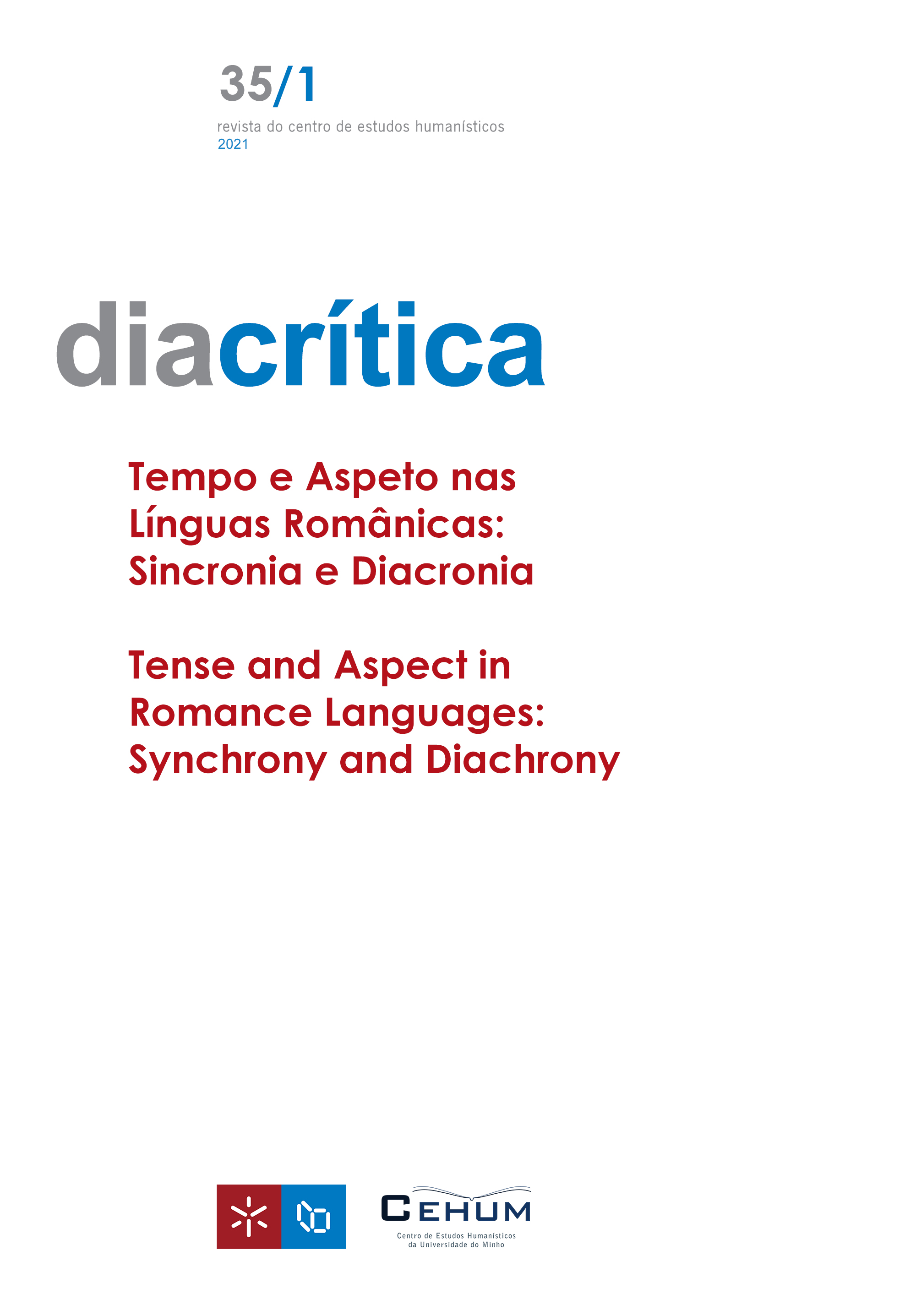Between aspect and negation The heterosemy of [deixar+de+vinf.]
DOI:
https://doi.org/10.21814/diacritica.5114Keywords:
Periphrasis, Aspectuality, Polarity, HeterosemyAbstract
Founded on the theoretical and methodological premises of the Usage-Based Models (Bybee 2016; Goldberg 1995, 2006; Traugott & Trousdale 2013), in this paper, we analyze the micro-construction [deixar+de+Vinf.] from the semantic domains of aspect and polarity. Since they are linked, by a heterosemy link (Lichetenberk 1991), in different taxonomic networks of Portuguese, we demonstrate that these micro-constructions originate from the transitive construction with the verb deixar, whose central meaning is distancing. Based on data extracted from the Corpus do Português (Davis & Ferreira 2006, 2016), we describe the singularities of the micro-constructions through a diachronic quantitative and qualitative analysis of parameters semantic entity type represented by the subject of the micro-construction and semantic type of Vinf.,. At the end, the results allow us to prove the hypothesis that these micro-constructions emerge from relations with other ones already existing and they gradually abstract sanctioning a greater variety of semantic subject and Vinf. types.
References
Barlow, M., & Kemmer, S. (Eds.). (2000). Usage-based models of language. Stanford, CA: CSLI.
Barðdal, J. (2008). Productivity: Evidence from case and argument structure in Icelandic. Amsterdam: John Benjamins. DOI: https://doi.org/10.1075/cal.8
Bybee, J. (2016). Língua, uso e cognição. Trad. Maria Angélica Furtado da Cunha. Revisão téc. Sebastião Carlos Leite Gonçalves. São Paulo: Cortez.
Camacho, R. G., Dall’Aglio-Hattnher, M., & Gonçalves, S. (2014). O substantivo. In R. Ilari (Ed.), Palavras de classe aberta (pp. 13–56). São Paulo: Contexto.
Castilho, A. T. (2002). Aspecto verbal no português falado. In M. B. Abaurre & A. C. S. Rodrigues (Eds.), Gramática do português falado (Vol. 8., pp. 83–121). Campinas: Editora da Unicamp.
Comrie, B. (1976). Aspect: An introduction to the study of verbal aspect and related problems. Cambrigde: Cambrigde University Press.
Cunha, A. G. (2014). Vocabulário histórico-cronológico do português medieval (Ed. rev.). Rio de Janeiro: Fundação Casa Rui Barbosa.
Cunha, L. F. (2013). Aspeto. In E. Raposo et al. (Eds.), Gramática do Português (Vol. 1, pp. 585–616). Lisboa: Fundação Calouste Gulbenkian.
Davies, M., & Ferreira, M. (2006). Corpus do português (45 milhões de palavras, 1300s-1900s). Consultado em http://www.corpusdoportugues.org
Davies, M., & Ferreira, M. (2016). Corpus do português (1 bilhão de palavras, Web/Dialetos). Consultado em em maio 2020 https://www.corpusdoportugues.org/web-dial/ Ferreiro, M. (2014). Glosario da poesía medieval profana galego-portuguesa. Coruña: Universidade da Coruña. Consultado em http://glossa.gal Gaffiot, F. (1934). Dictionnaire illustré latin-français. Paris: Hachette.
Givón, T. (2001). Syntax: An introduction (Vols, 1–2). Amsterdam: John Benjamins. DOI: https://doi.org/10.1075/z.syn2
Givón, T. (2018). On understanding grammar. Amsterdam: John Benjamins. DOI: https://doi.org/10.1075/z.213
Goldberg, A. E. (1995). Constructions: A construction grammar approach to argument structure. Chicago: University of Chicago Press.
Goldberg, A. E. (2006). Constructions at work: The nature of generalization in language. Oxford: Oxford University Press. DOI: https://doi.org/10.1093/acprof:oso/9780199268511.001.0001
Heine, B. (1993). Auxiliaries: Cognitive forces and grammaticalization. Oxford: Oxford University Press.
Karttunen, L. (1971). Implicative verbs. Language, 47(2), 340–358. https://doi.org/10.2307/412084 DOI: https://doi.org/10.2307/412084
Langacker, R. W. (1987). Foundations of Cognitive Grammar, Vol. 1: Theoretical Prerequisites. Stanford: Stanford University Press.
Langacker, R. W. (2008). Cognitive grammar: A basic introduction. New York: Oxford University Press. DOI: https://doi.org/10.1093/acprof:oso/9780195331967.001.0001
Langacker, R. W. (2013). Essentials of cognitive grammar. New York: Oxford University Press. DOI: https://doi.org/10.1093/oxfordhb/9780199544004.013.0005
Lichtenberk, F. (1991). Semantic change and heterosemy in grammaticalization. Language, 67, 475–509. https://doi.org/10.2307/415035 DOI: https://doi.org/10.1353/lan.1991.0009
Lobato, L. (1975). Os verbos auxiliares em português contemporâneo: critérios de auxiliaridade. In L. Lobato et al. (Eds.), Análises linguísticas (pp. 27–91). Petrópolis: Vozes.
Peres, J. (2013). Negação. In E. Raposo et al. (Eds.), Gramática do Português (Vol. 1. pp. 461–498). Lisboa: Fundação Calouste Gulbenkian.
Prezotto Júnior, J. R. (2020). As microconstruções auxiliares com "deixar" e "parar" no português na expressão de aspecto final (Dissertação de mestrado, UNESP, São Paulo, Brasil).
Prezotto Júnior, J. R., & Souza, E. R. F. (2019). As microconstruções do verbo-suporte com deixar no português brasileiro. Diadorim, 21(2), 188–213.
Raposo, E. (2013). Verbos auxiliares. In E. Raposo et al. (Eds.), Gramática do Português (Vol. 2, pp. 1221–1281). Lisboa: Fundação Calouste Gulbenkian.
Soares da Silva, A. (1999). A Semântica de deixar. Uma contribuição para a abordagem cognitiva em semântica lexical. Lisboa: Fundação Calouste Gulbenkian.
Soares da Silva, A. (2011). (Inter)Subjectificação na linguagem e na mente. Revista Portuguesa de Humanidades - Estudos Linguísticos, 15(1), 93–110.
Tavares, M. A., & Freitag, R. (2010). Do concreto ao abstrato: Influência do traço semântico-pragmático do verbo na gramaticalização em domínios funcionais complexos. Revista LinguíStica, 6(1), 103–119. https://doi.org/10.31513/linguistica.2010.v6n1a4442
Traugott, E. C., & Trousdale, G. (2013). Constructionalization and constructional changes. Oxford: Oxford University Press. DOI: https://doi.org/10.1093/acprof:oso/9780199679898.001.0001
Travaglia, L. C. (2014). O aspecto verbal no português: A categoria e sua expressão (5.ª ed.). Uberlândia: Universidade Federal de Uberlândia. Xavier, M. F., Vicente, G., & Crispim, M. L. (Eds.) (2003). Dicionário de verbos portugueses dos séculos 12 e 13/14. Lisboa: Faculdade de Ciências Sociais e Humanas, Universidade Nova de Lisboa. Consultado em http://cipm.fcsh.unl.pt
Downloads
Published
How to Cite
Issue
Section
License
Copyright (c) 2023 José Roberto Prezotto Júnior, Sebastião Carlos Leite Gonçalves

This work is licensed under a Creative Commons Attribution-NonCommercial 4.0 International License.










